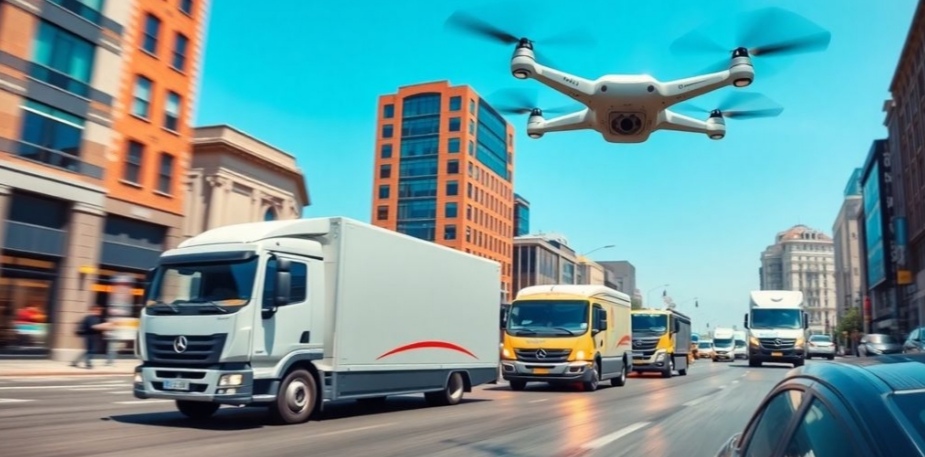Introduction
E-commerce logistics have evolved significantly over the years. In the early days of online shopping, customers were accustomed to waiting a week or more for deliveries.
The introduction of two-day shipping by giants like Amazon changed consumer expectations, making fast delivery a competitive advantage. But as 2025 unfolds, the race for even faster and more efficient delivery methods is reshaping the logistics landscape.
Instant delivery is the next frontier in e-commerce logistics. Imagine placing an order and receiving it within minutes—this is no longer a futuristic dream but a rapidly growing reality. Companies like Meituan and JD.com are pioneering this shift, pushing the boundaries of logistics capabilities.
As consumer preferences shift towards immediacy, businesses are leveraging technology to meet these demands. The key question now is: How are businesses making this possible? Let’s explore.
The Rise of Quick Commerce (Q-Commerce)
What is Q-Commerce?
Quick Commerce, or Q-Commerce, is a hyper-fast version of traditional e-commerce. Unlike standard online shopping, which takes days, Q-Commerce delivers goods within a few hours—or even minutes. Speed and convenience define this model, catering to consumers who value instant gratification.
Ecommerce platforms such as Meituan and JD.com are setting new benchmarks in Q-Commerce. They leverage cutting-edge logistics, AI-powered route optimization, and localized fulfillment centers to ensure rapid delivery. These advancements are not just improving speed but also transforming the way consumers interact with e-commerce.
With Q-Commerce, consumers now expect near-instant delivery. The days of patiently waiting for online orders are fading, replaced by an era where shoppers demand efficiency. However, businesses must balance speed with service quality. While faster delivery enhances customer satisfaction, maintaining high product and service standards remains critical.
Technological Innovations Driving Instant Delivery
AI and Automation in Logistics
Automation and artificial intelligence (AI in logistics) are the backbone of instant delivery. AI optimizes delivery routes, predicts demand patterns, and streamlines warehouse management. This results in faster deliveries, reduced operational costs, and improved supply chain efficiency. Real-time AI adjustments help companies cut delays and ensure seamless logistics.
Autonomous Vehicles and Drones for Last-Mile Delivery
Autonomous vehicles and drones are redefining last-mile delivery. Amazon’s drone delivery program, for instance, aims to make rapid shipping even more accessible. These technologies minimize human intervention, lower transportation costs, and reduce reliance on traditional delivery methods.
Real-Time Data Analytics for Delivery Optimization
Real-time data analytics allows businesses to anticipate delivery bottlenecks and optimize dispatch times. By analyzing traffic conditions, weather patterns, and customer preferences, companies can improve the accuracy of delivery time predictions. This innovation enhances efficiency while improving the overall customer experience.
Hyper-Local Fulfillment Strategies
Businesses are turning to micro-filament centers (MFCs) to facilitate rapid delivery. These small-scale warehouses, located in densely populated areas, enable quick dispatch of goods. Retailers like Walmart and Amazon are investing in MFCs to reduce delivery time and meet growing consumer demands.
Dark Stores and Their Growing Significance
Dark stores—retail locations solely dedicated to fulfilling online orders—are becoming a crucial part of logistics strategies. By removing in-store customer foot traffic, dark stores can operate more efficiently and speed up order processing. Retail giants such as Tesco and Carrefour are leveraging dark stores to streamline logistics and enhance delivery speed.
Sustainability in Rapid Delivery
While instant delivery is convenient, it raises sustainability concerns. Faster shipping often means more vehicles on the road, increasing carbon emissions. The challenge lies in balancing speed with environmentally responsible logistics.
Green Logistics Initiatives
To address environmental concerns, companies are adopting green logistics solutions. Electric delivery vehicles, bicycle couriers, and alternative packaging materials are gaining traction. Amazon’s fleet of electric delivery vans and biodegradable packaging initiatives are examples of sustainability efforts within logistics.
Balancing Speed and Environmental Responsibility
As businesses strive for instant delivery, they must also prioritize sustainable practices. Route optimization, carbon offset programs, and eco-friendly warehousing are key steps toward reducing the environmental impact of rapid delivery.
The Competitive Landscape and Strategic Partnerships
Industry leaders like Amazon and Walmart are continually expanding their logistics capabilities. Investments in warehouse automation, AI-driven fulfillment, and real-time tracking systems are shaping the next era of e-commerce logistics.
Startups and Emerging Players in Instant Delivery
Beyond the industry giants, startups are entering the instant delivery space, leveraging agility and innovation. Companies like Gorillas and Getir focus on hyper-local deliveries, proving that smaller players can thrive in this competitive landscape.
The Role of Strategic Partnerships
Retailers and logistics providers are forming strategic alliances to enhance delivery speed and efficiency. Third-party logistics (3PL) providers play a crucial role in expanding fulfillment networks, enabling businesses to scale their delivery operations.
Conclusion
E-commerce logistics in 2025 is all about speed, efficiency, and technological innovation. With Q-Commerce leading the charge, AI-powered automation, micro-fulfillment centers, and sustainable delivery solutions are shaping the future. As businesses strive to keep up with consumer expectations, logistics will continue to evolve at a rapid pace. The question remains: How will companies balance instant delivery with environmental and operational sustainability? The answers will define the next phase of e-commerce logistics.

